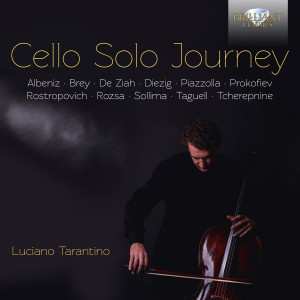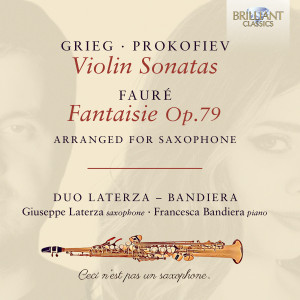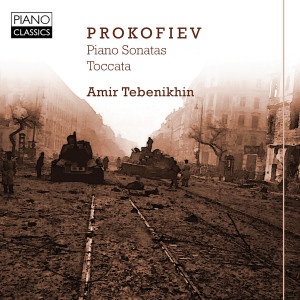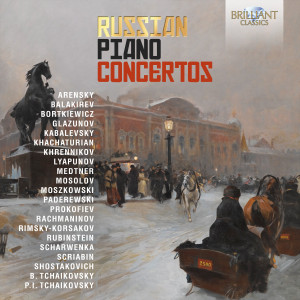Sergei Prokofiev
Story
Sergej Prokofiev was born in Sontsovka (now the village of Krasne in Donetsk oblast), Russian Empire (now Ukraine) as an only child. His mother was a pianist and his father a relatively wealthy agricultural engineer. Prokofiev displayed unusual musical abilities at an early age and in 1902, when he started taking private lessons in composition, he had already produced a number of pieces. As soon as he had the necessary theoretical tools he quickly started experimenting, laying the base for his own musical style. After a while, Prokofiev felt that the isolation in Sontsovka was restricting his further musical development. Although his parents were not too keen on forcing their son into a musical career at such an early age, in 1904 he moved to St Petersburg and applied to the Academy of Music. He passed the introductory tests and started his composition studies the same year, being several years younger than most of his classmates. He was viewed as eccentric and arrogant, and he often expressed dissatisfaction with much of the education, which he found boring. During this period he studied under, among others, Nikolai Rimsky-Korsakov. He also became friends with Boris Asafiev and Nikolai Myaskovsky.
In the St Petersburg music scene, Sergei would gradually get a reputation as an enfant terrible, while also getting praise for his original compositions which he would perform himself on the piano. In 1909 he graduated from his class in composition, getting less than impressive marks. He continued at the academy, but now concentrated on playing the piano and conducting. His piano lessons went far from smoothly, but the composition classes made an impression on him. His teacher encouraged his musical experimentation, and his works from this period display more intensity than earlier ones. In 1910 Prokofiev’s father died and Sergei’s economic support ceased. Luckily, at that time he had started making a name for himself as a composer, although he frequently caused scandals with his forward-looking works. His first two piano concertos were composed around this time. In 1914 Prokofiev left the academy, this time with the highest marks, which won him a grand piano. Soon afterwards he made a trip to London where he made contact with Sergei Diaghilev and Igor Stravinsky. During World War I, Prokofiev returned again to the academy, now studying organ. He composed an opera based on Fyodor Dostoyevsky’s novel The Gambler, but the rehearsals were plagued by problems and the premiere scheduled for 1917 had to be cancelled because of the February Revolution. In summer the same year, Prokofiev composed his first symphony, the Classical. This was his own name for the symphony, which was composed in a style inspired by, for example, Joseph Haydn (see Neoclassicism (music)). After a brief stay with his mother in Kislovodsk, Kaukasus, because of worries of the enemy capturing Petrograd (the new name for St Petersburg), he returned in 1918, but he was now determined to leave Russia, at least temporarily. In the current Russian state of unrest he saw no room for his experimental music and in May he headed for the USA.
Life abroad: Arriving in San Francisco he was immediately compared to other famous ‘exile’ Russians (such as Sergei Rachmaninoff), and he started out successfully with a solo concert in New York, leading to several further engagements. He also received a contract for the production of his new opera The Love for Three Oranges, but due to illness and the death of the conductor the premiere was cancelled, another example of Prokofiev’s bad luck in operatic matters. The failure also cost him his American solo career, since the opera took too much time and effort. He soon found himself in financial difficulties, and in April 1920 he left for Paris, not wanting to return to Russia as a failure. Paris was better prepared for Prokofiev’s musical style. He reaffirmed his contacts with the Diaghilev’s Ballets Russes and with Stravinsky, and returned to some of his older unfinished works such as the third piano concerto. Later, in 1921, The Love for Three Oranges finally premiered in Chicago, but the reception was cold, forcing Prokofiev to leave America again without triumph. Now Prokofiev moved with his mother to the Bavarian Alps for over a year, so as to concentrate fully on his composing. Mostly he spent time on an old opera project, The Fiery Angel. By this time his later music had started sifting back into Russia and he received invitations to return there, but he felt that his new European career was more important. In 1923 he married the Spanish singer Lina Llubera, before moving back to Paris. There a number of his works (for example the Second Symphony) were performed, but critical reception was lukewarm, perhaps because he could no longer really lay claim to being a ‘novelty’. He did not particularly like Stravinsky’s later works and even though he was quite friendly with members of ‘Les Six’, musically he had very little in common with them.
Around 1927 things started looking up; he had some exciting commissions from Diaghilev and made a number of concert tours in Russia; in addition he enjoyed a very successful staging of The Love for Three Oranges in Leningrad (as Petrograd was now known). Two older operas (one of them The Gambler) were also played in Europe and in 1928 he produced the Third Symphony which was broadly based on his unperformed opera The Fiery Angel. The years 1931 and 1932 saw the completion of his fourth and fifth piano concertos.
In 1929 he had a car accident in which his hands were slightly injured, preventing him from touring in Moscow, but permitting him to enjoy some of the contemporary Russian music instead. After his hands healed he made a new attempt at touring in the USA, and this time he was received very warmly, propped up by his recent success in Europe. This in turn propelled him to do a large tour through Europe.
In the early 1930s Prokofiev was starting to long for Russia again, moving more and more of his premieres and commissions to his home country instead of Paris. An example of the later is Lieutenant Kije, which was commissioned as the score to a Russian film. Another commission, from the Kirov Theatre in Leningrad, was the ballet Romeo and Juliet, today one of Prokofiev’s best known works. However, there were numerous choreographical problems, postponing the premiere for several years.
Return to Russia
In 1936 Prokofiev and his family moved back to Russia permanently. At this time, the official Russian policy towards music changed; a special bureau, the ‘Composers’ Union’, was established in order to keep track of the artists and their doings, and regulations were drawn up outlining what kind of music was acceptable. These policies would gradually cause almost complete isolation for the Russian composers from the rest of the world, by limiting outside influences. Still mostly untouched by this, Prokofiev turned to composing music for children (Three Songs for Children, Peter and the Wolf, and so on) as well as the gigantic Cantata for the Twentieth Anniversary of the October Revolution, which was, however, never performed. The premiere of the opera Semyon Kotko was postponed, this time because the producer Vsevolod Meyerhold was imprisoned and executed. Most of Prokofiev’s opera projects were plagued by ill luck.
In 1941 Sergei suffered his first heart attack. It would be followed by others, resulting in a gradual decline in health. Because of the war, he was periodically evacuated south together with a large number of other artists. This had consequences for his family life in Moscow, and his relationship with the 25-year-old Mira Mendelson finally led to his separation from his wife, although they remained married. It should also be mentioned that marriage with foreigners was made illegal at this time and that the breakup with his wife was probably forced.
The outbreak of war inspired Prokofiev to a new opera project, War and Peace, which he worked on for two years, along with more film music for Sergei Eisenstein (Ivan the Terrible) and the second string quartet. However, the Union had many opinions about the opera which had to undergo numerous revisions and no premiere. In 1944, Prokofiev moved to an estate outside of Moscow, to compose his Fifth Symphony which would turn out to be his most successful. It was overwhelmingly received, but shortly afterwards, Sergei suffered a concussion from which he never really recovered, and which severely lowered his productivity in later years.
Prokofiev had time to write his Sixth Symphony and a ninth piano sonata (his last) before the Party suddenly changed its opinion about his music. The end of the war allowed the attention to turn inwards again and the Party saw fit to tighten its reins on domestic artists. Prokofiev’s music was now suddenly seen as a grave example of ‘formalism’, and generally dangerous to the Soviet people.
On February 20, 1948 his wife Lina was arrested for ‘espionage’—she tried to send money to her mother in Spain via an embassy. She was sentenced to 20 years, but was eventually released after Stalin’s death and later left the Soviet Union; her later years were financially secure due to music royalties. In that same year, Prokofiev married Mira.
His latest opera projects were quickly cancelled from the Kirov Theatre and this, in combination with his declining health, caused Prokofiev to retire more and more from the scene. Most of his later compositions come across as lame, missing the old ‘spark’. His last performance was in connection with the premiere of the Seventh Symphony in 1952. He died from a cerebral haemorrhage on 5 March 1953 (ironically, the same day as Stalin). He is buried in the Novodevichy Cemetery, Moscow, Russia.
Details
- Composer
- Sergei Prokofiev
- Date of birth
- 23 april 1891
- Nationality
- Russian
- Albums
- 9
- Tracks
- 44
9 albums
-

Sergei Prokofiev, Isaac Albéniz and 10 others
Cello Solo Journey
-

Gabriel Fauré, Sergei Prokofiev and Edvard Grieg
Grieg & Prokofiev: Violin Sonatas, Fauré: Fantaisie, Op. 79, arranged for Saxophone
-

Sergei Prokofiev
Prokofiev: Piano Sonatas 4-7-8, Toccata
-

Sergei Prokofiev
Prokofiev: The War Sonatas
-

Piotr Ilyich Tchaikovsky, Alexander Glazunov and 3 others
Rachmaninoff & Prokofiev: Cello Sonatas
-

Alexander Scriabin, Sergei Rachmaninoff and Sergei Prokofiev
Rachmaninoff: Moments Musicaux, Vocalise - Scriabin: Sonata No. 5 - Prokofiev: Sonata No. 7
-

Aram Ilyich Khachaturian, Piotr Ilyich Tchaikovsky and 18 others
Russian Piano Concertos
-

Franz Schubert, Alexander Scriabin and 6 others
Sergio Fiorentino: The Legacy, Vol. 1
-

Alexander Scriabin, Sergei Prokofiev and 2 others
Virtuoso Piano Music
